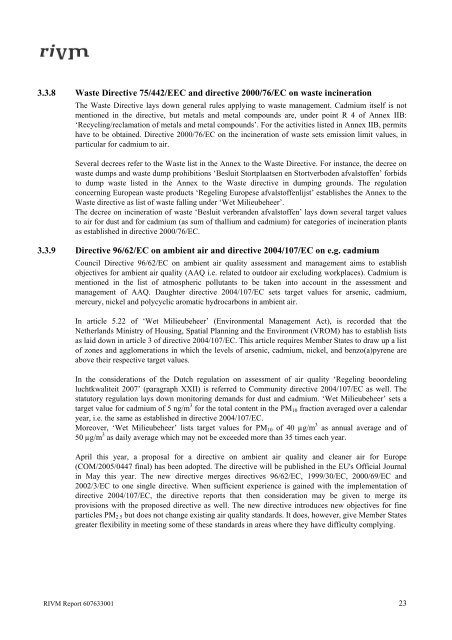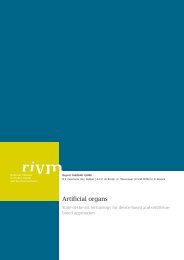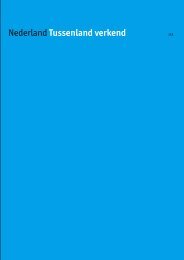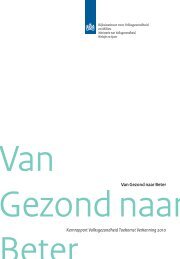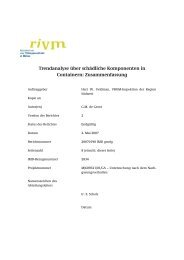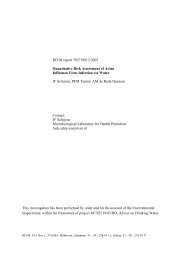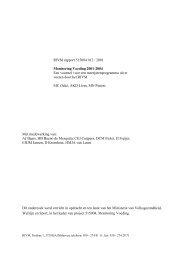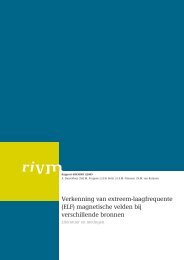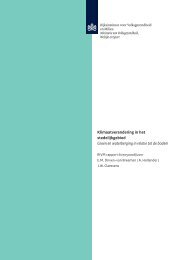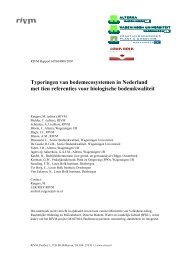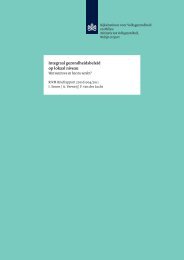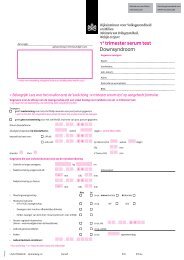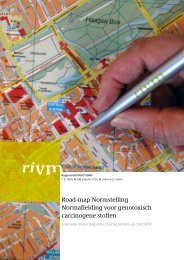RIVM report 607633001 EU-wide control measures to reduce ...
RIVM report 607633001 EU-wide control measures to reduce ...
RIVM report 607633001 EU-wide control measures to reduce ...
Create successful ePaper yourself
Turn your PDF publications into a flip-book with our unique Google optimized e-Paper software.
3.3.8 Waste Directive 75/442/EEC and directive 2000/76/EC on waste incineration<br />
The Waste Directive lays down general rules applying <strong>to</strong> waste management. Cadmium itself is not<br />
mentioned in the directive, but metals and metal compounds are, under point R 4 of Annex IIB:<br />
‘Recycling/reclamation of metals and metal compounds’. For the activities listed in Annex IIB, permits<br />
have <strong>to</strong> be obtained. Directive 2000/76/EC on the incineration of waste sets emission limit values, in<br />
particular for cadmium <strong>to</strong> air.<br />
Several decrees refer <strong>to</strong> the Waste list in the Annex <strong>to</strong> the Waste Directive. For instance, the decree on<br />
waste dumps and waste dump prohibitions ‘Besluit S<strong>to</strong>rtplaatsen en S<strong>to</strong>rtverboden afvals<strong>to</strong>ffen’ forbids<br />
<strong>to</strong> dump waste listed in the Annex <strong>to</strong> the Waste directive in dumping grounds. The regulation<br />
concerning European waste products ‘Regeling Europese afvals<strong>to</strong>ffenlijst’ establishes the Annex <strong>to</strong> the<br />
Waste directive as list of waste falling under ‘Wet Milieubeheer’.<br />
The decree on incineration of waste ‘Besluit verbranden afvals<strong>to</strong>ffen’ lays down several target values<br />
<strong>to</strong> air for dust and for cadmium (as sum of thallium and cadmium) for categories of incineration plants<br />
as established in directive 2000/76/EC.<br />
3.3.9 Directive 96/62/EC on ambient air and directive 2004/107/EC on e.g. cadmium<br />
Council Directive 96/62/EC on ambient air quality assessment and management aims <strong>to</strong> establish<br />
objectives for ambient air quality (AAQ i.e. related <strong>to</strong> outdoor air excluding workplaces). Cadmium is<br />
mentioned in the list of atmospheric pollutants <strong>to</strong> be taken in<strong>to</strong> account in the assessment and<br />
management of AAQ. Daughter directive 2004/107/EC sets target values for arsenic, cadmium,<br />
mercury, nickel and polycyclic aromatic hydrocarbons in ambient air.<br />
In article 5.22 of ‘Wet Milieubeheer’ (Environmental Management Act), is recorded that the<br />
Netherlands Ministry of Housing, Spatial Planning and the Environment (VROM) has <strong>to</strong> establish lists<br />
as laid down in article 3 of directive 2004/107/EC. This article requires Member States <strong>to</strong> draw up a list<br />
of zones and agglomerations in which the levels of arsenic, cadmium, nickel, and benzo(a)pyrene are<br />
above their respective target values.<br />
In the considerations of the Dutch regulation on assessment of air quality ‘Regeling beoordeling<br />
luchtkwaliteit 2007’ (paragraph XXII) is referred <strong>to</strong> Community directive 2004/107/EC as well. The<br />
statu<strong>to</strong>ry regulation lays down moni<strong>to</strong>ring demands for dust and cadmium. ‘Wet Milieubeheer’ sets a<br />
target value for cadmium of 5 ng/m 3 for the <strong>to</strong>tal content in the PM10 fraction averaged over a calendar<br />
year, i.e. the same as established in directive 2004/107/EC.<br />
Moreover, ‘Wet Milieubeheer’ lists target values for PM10 of 40 µg/m 3 as annual average and of<br />
50 µg/m 3 as daily average which may not be exceeded more than 35 times each year.<br />
April this year, a proposal for a directive on ambient air quality and cleaner air for Europe<br />
(COM/2005/0447 final) has been adopted. The directive will be published in the <strong>EU</strong>'s Official Journal<br />
in May this year. The new directive merges directives 96/62/EC, 1999/30/EC, 2000/69/EC and<br />
2002/3/EC <strong>to</strong> one single directive. When sufficient experience is gained with the implementation of<br />
directive 2004/107/EC, the directive <strong>report</strong>s that then consideration may be given <strong>to</strong> merge its<br />
provisions with the proposed directive as well. The new directive introduces new objectives for fine<br />
particles PM2.5 but does not change existing air quality standards. It does, however, give Member States<br />
greater flexibility in meeting some of these standards in areas where they have difficulty complying.<br />
<strong>RIVM</strong> Report <strong>607633001</strong> 23


